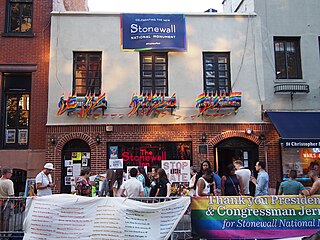 W
WQueer theory is a field of critical theory that emerged in the early 1990s out of the fields of queer studies and women's studies. "Queer theory" can have various meanings depending upon its usage. Two common usages of queer theory include a (1) methodology for literary analysis and (2) a productive practice of theory. A literary methodology could include queer readings of texts, that is, textual interpretations which are presented from a queer perspective. While the theorization of 'queerness' works to produce ideas which relate to how queerness can be understood in various disciplinary contexts.
 W
WComing to Power: Writings and Graphics on Lesbian S/M is a 1981 book edited by members of the lesbian feminist S/M organisation Samois. It is an anthology of lesbian S/M writings. It was a founding work of the lesbian BDSM movement.
 W
WFeminist Formations is a peer-reviewed academic journal established in 1988 as the NWSA Journal ; the name was changed beginning with the Spring 2010 issue. It publishes interdisciplinary and multicultural feminist scholarship in women's, gender, and sexuality studies linking feminist theory with teaching and activism. In addition to its essays focusing on feminist scholarship and its reviews of books, the journal regularly publishes special issues focused on topics especially important in the field of women’s, gender, and sexuality studies and also features vibrant cover art and poetry and cutting-edge feminist artists and poets. The journal is edited by Patti Duncan, a professor of Women, Gender, and Sexuality Studies at Oregon State University, and is published three times per year by the Johns Hopkins University Press.
 W
WGender Trouble: Feminism and the Subversion of Identity is a book by the philosopher Judith Butler, in which the author argues that gender is a kind of improvised performance. The work is influential in feminism, women's studies, and lesbian and gay studies, and has also enjoyed widespread popularity outside of traditional academic circles. Butler's ideas about gender came to be seen as foundational to queer theory and the advancing of dissident sexual practices during the 1990s.
 W
WHeterotopia is a concept elaborated by philosopher Michel Foucault to describe certain cultural, institutional and discursive spaces that are somehow ‘other’: disturbing, intense, incompatible, contradictory or transforming. Heterotopias are worlds within worlds, mirroring and yet upsetting what is outside. Foucault provides examples: ships, cemeteries, bars, brothels, prisons, gardens of antiquity, fairs, Muslims baths and many more. Foucault outlines the notion of heterotopia on three occasions between 1966-67. A talk given to a group of architects is the most well-known explanation of the term. His first mention of the concept is in his preface to 'The Order of Things' and refers to texts rather than socio-cultural spaces.
 W
WIntersex people are born with sex characteristics, such as chromosomes, gonads, or genitals that, according to the UN Office of the High Commissioner for Human Rights, "do not fit typical binary notions of male or female bodies". "Because their bodies are seen as different, intersex children and adults are often stigmatized and subjected to multiple human rights violations".
 W
WLesbian, gay, bisexual, and transgender (LGBT) social movements are social movements that advocate for LGBT people in society. Social movements may focus on equal rights, such as the 2000s movement for same-sex marriage, or they may focus on liberation, as in the gay liberation movement of the 1960s and 1970s. Earlier movements focused on self-help and self-acceptance, such as the homophile movement of the 1950s. Although there is not a primary or an overarching central organization that represents all LGBT people and their interests, numerous LGBT rights organizations are active worldwide. The earliest organizations to support LGBT rights were formed in the early 20th century.
 W
WPink capitalism is the incorporation of the LGBT movement and sexual diversity to capitalism and the market economy, viewed especially in a critical lens as this incorporation pertains to the LGBT, Western, white, and affluent, upper middle class communities and market.
 W
WQueer studies, sexual diversity studies, or LGBT studies is the study of issues relating to sexual orientation and gender identity usually focusing on lesbian, gay, bisexual, transgender, gender dysphoria, asexual, queer, questioning, intersex people and cultures.
 W
WQueer Tango is to dance Argentine tango without regard to the traditional heteronormative roles of the dancers, and often to exchange the leader and follower roles. Therefore, it is related to open role or same-sex tango. The queer tango movement permits not only an access to tango for the LGBT community, but also supports female leaders and male followers, regardless of orientation.
 W
WJohn Addington Symonds, Jr. was an English poet and literary critic. A cultural historian, he was known for his work on the Renaissance, as well as numerous biographies of writers and artists. Although he married and had a family and could possibly have passed as straight, he put his personal well-being on the line by advocating for male love (homosexuality), which he believed could include pederastic as well as egalitarian relationships, referring to it as l'amour de l'impossible. He also wrote much poetry inspired by his same-sex affairs.
 W
WQueer theology is a theological method that has developed out of the philosophical approach of queer theory, built upon scholars such as Michel Foucault, Gayle Rubin, Eve Kosofsky Sedgwick, and Judith Butler. Queer theology begins with an assumption that gender non-conformity and gay, lesbian and bisexual desire have always been present in human history, including the Bible. It was at one time separated into two separate theologies; gay theology and lesbian theology. Later, the two would merge to become the more inclusive term of queer theology.